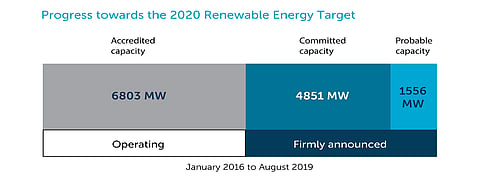

Australia's Clean Energy Regulator (CER) has confirmed the country will achieve its 33,000 GWh goal of additional renewable energy in 2020 under its Large-Scale Renewable Energy Target (RET). It has now approved enough capacity for this. "It is now certain Australia will generate enough renewable energy to meet the 2020 Large-scale Renewable Energy Target," said CER Chair David Parker.
The announcement came as the agency met the milestone on August 30, 2019 with the approval of four large-scale wind and solar power stations with a combined capacity of 406 MW.
In August 2019, CER in its administrative report showed confidence about the country exceeding the 33,000 GWh target in 2020 (see Australia To Exceed LRET Target In 2020: CER).
Between 2017 and 2019, Australia was supposed to have built 6.4 GW of this capacity for the 33,000 GWh target which has now been achieved. CER says it is currently tracking another 6.41 GW of renewable energy capacity to be built over the coming years.
"While future investment faces a number of constraints, this is by no means the end of renewable energy investment in Australia, with markets continuing to innovate and adapt to opportunities and challenges," Parker said, offering comforting words to the renewable energy industry that has been wondering about the way forward for the country once it will have met its 2020 target.
Celebrating the milestone, Clean Energy Council Chief Executive Kane Thornton said, "The industry doesn't need new subsidy, we just need certainty – renewable energy can continue to create opportunities for regional parts of the country for many decades with the right policies in place. We've always said that if you set us a target, we will beat it. We've hit the bullseye with a year to go, and it's time to start asking ourselves what comes next."
However, Giles Parkinson of Australian renewable energy news portal RenewEconomy cautioned that before declaring the target is met, the CER should probably wait until all that wind and energy capacity is actually on line and producing the mandated 33,000 GWh 'given the delays in connections and commissioning which is affecting so many projects'.
